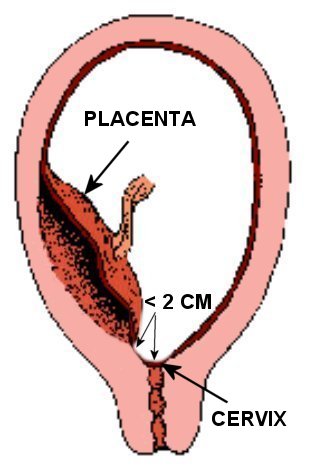Reviewed by Medical Advisory Board
The placenta, also called the afterbirth, is the
organ that develops during pregnancy between the mother and the fetus. The
placenta has many blood vessels that allow oxygen and food to flow from the
mother to the fetus. A placenta that is too close to the cervix after 16
weeks is called low lying if the edge of the placenta or the enlarged vein
at the edge of the placenta (marginal sinus) is less than 2 centimeters away
from the opening of the cervix
A low lying placenta does not appear to affect the growth or development of the fetus. However, bleeding may occur from the blood vessels of the placenta during pregnancy or at the time of delivery.
Because of the increased risk for bleeding, you may be asked to avoid sexual intercourse
, exercise , and unnecessary travel.
|

LifeART images
© 2006
Lippincott Williams & Wilkins. All rights reserved.
|
As a pregnancy progresses the placenta
tends to grow towards the upper uterus and most low-lying placentas will
have "moved away" from the cervix by the third trimester. A follow up
ultrasound is, therefore, recommended to be done at 32 weeks to
re-examine the location of the placenta. If the placenta is still less
than 2 centimeters away from the cervix at 32 weeks, then another exam
is recommended at 36 weeks,
Women who continue to have a
low-lying placenta at term may have a vaginal delivery if the placental edge is greater than 1 centimeter away from the cervix, but have a
higher chance of an emergency cesarean section if the placenta is 1 centimeter or less away from the cervix
. One study found hemorrhage after delivery was more common in women
diagnosed with a low lying placenta, whether or not the low lying placenta resolved.
By Mark Curran, MD
FACOG Updated 9/29/2025
REFERENCES
1. Reddy UM, Abuhamad AZ, Levine D, Saade GR; Fetal Imaging Workshop Invited Participants. Fetal imaging: executive summary of a joint Eunice Kennedy Shriver National Institute of Child Health and Human Development, Society for Maternal-Fetal Medicine, American Institute of Ultrasound in Medicine, American College of Obstetricians and Gynecologists, American College of Radiology, Society for Pediatric Radiology, and Society of Radiologists in Ultrasound Fetal Imaging Workshop. J Ultrasound Med. 2014 May;33(5):745-57. doi: 10.7863/ultra.33.5.745. PMID: 24764329.
2. Ohira S, Kikuchi N, Kobara H, Osada R, Ashida T, Kanai M, Shiozawa T. Predicting the route of delivery in women with low-lying placenta using transvaginal ultrasonography: significance of placental migration and marginal sinus. Gynecol Obstet Invest. 2012;73(3):217-22. doi: 10.1159/000333309. Epub 2012 Mar 1. PMID: 22378482.https://pubmed.ncbi.nlm.nih.gov/22378482/
3. Ogueh O, Morin L, Usher RH, Benjamin A. Obstetric implications of low-lying placentas diagnosed in the second trimester. Int J Gynaecol Obstet. 2003 Oct;83(1):11-7. doi: 10.1016/s0020-7292(03)00211-x. PMID: 14511867.
4. https://wwwnc.cdc.gov/travel/yellowbook/2020/family-travel/pregnant-travelers#box702
5. Meah VL, Davies GA, Davenport MH. Why can't I exercise during pregnancy? Time to revisit medical 'absolute' and 'relative' contraindications: systematic review of evidence of harm and a call to action. Br J Sports Med. 2020 Dec;54(23):1395-1404. doi: 10.1136/bjsports-2020-102042. Epub 2020 Jun 8. PMID: 32513676.
6. Jansen C, de Mooij YM, Blomaard CM, Derks JB, van Leeuwen E, Limpens J, Schuit E, Mol BW, Pajkrt E. Vaginal delivery in women with a low-lying placenta: a systematic review and meta-analysis. BJOG. 2019 Aug;126(9):1118-1126. doi: 10.1111/1471-0528.15622. Epub 2019 Mar 10. PMID: 30663270.
7. Jain V, Bos H, Bujold E. Guideline No. 402: Diagnosis and Management of Placenta Previa. J Obstet Gynaecol Can. 2020 Jul;42(7):906-917.e1. doi: 10.1016/j.jogc.2019.07.019. PMID: 32591150.
8. Taga A, Sato Y, Sakae C, Satake Y, Emoto I, Maruyama S, Mise H, Kim T. Planned vaginal delivery versus planned cesarean delivery in cases of low-lying placenta. J Matern Fetal Neonatal Med. 2017 Mar;30(5):618-622. doi: 10.1080/14767058.2016.1181168. Epub 2016 May 16. PMID: 27180627.
9. DeBolt CA, Rosenberg HM, Pruzan A, Goldberger C, Kaplowitz E, Buckley A, Vieira L, Stone J, Bianco A. Patients with resolution of low-lying placenta and placenta previa remain at increased risk of postpartum hemorrhage. Ultrasound Obstet Gynecol. 2021 Nov 26. doi: 10.1002/uog.24825. Epub ahead of print. PMID: 34826174.
10.Froeliger A, et al. Trial of Labor Compared With Elective Cesarean Delivery for Low-Lying Placenta. Obstet Gynecol. 2022 Sep 1;140(3):429-438. PMID: 35926200.
|
|

